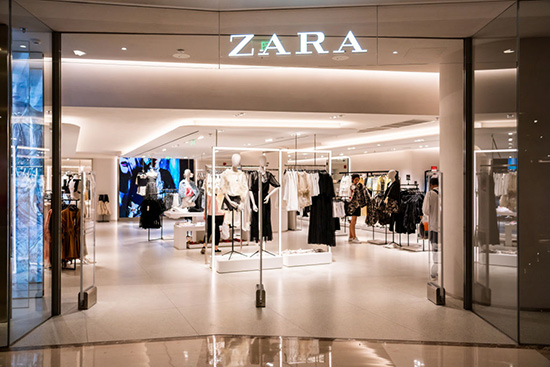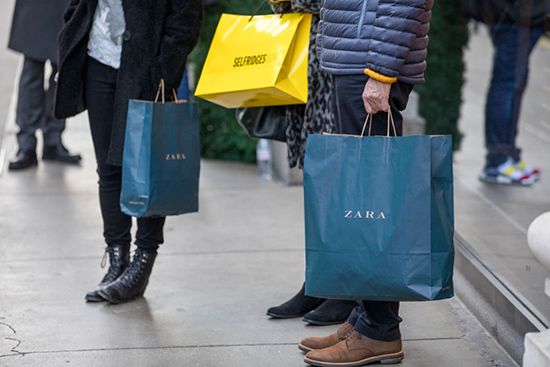H&M和Zara以退为进,关店促进增长
两家公司去年做出了精简实体店网络以及加大线上销售投入的决定,如今双方都看到了这一决定所带来的效益。
|
面对电商的威胁,欧洲快时尚巨头的动作一直以来十分缓慢,但在这场竞争中,它们更像是已经与对手拉开了足够的距离,不仅生存没有问题,甚至可能会走向繁荣。 瑞典H&M、Monki和Weekday品牌的母公司Hennes & Mauritz,以及西班牙Inditex(Zara和Massimo Dutti品牌的母公司)去年做出了精简实体店网络以及加大线上销售投入的决定,如今双方都看到了这一决定所带来的效益。 18个月前,H&M还在痛苦地对其在线店面进行再一次改造,而且似乎在拼命地开设更多盈利无望的店面。快进至股市异常动荡的今年夏天,H&M在最近6月底的季度财报中宣布,公司成功地保住了15%的业绩增长。这一业绩值得称道,原因有两个:第一,其夏季系列服饰非常畅销,销售额同比增长了12%;第二,公司称预计将连续第四个月削减其未售库存,并预测库存水平在本财年年底将继续下降。公司股价如今已经从去年8月创下的14年以来的最低水平,上涨了三分之一。 |
Europe’s fast fashion giants may have been slow to wake up to the threat posed by e-commerce, but it looks more and more like they have raised their game enough to survive—and maybe even prosper. Hennes & Mauritz, the Swedish company behind H&M, Monki and Weekday, and Spain-based Inditex (owner of Zara and Massimo Dutti) are both seeing the benefits of decisions taken last year to trim their networks of physical stores and throw more resources into online sales. Eighteen months ago, H&M was still struggling with another makeover of its online store and seemingly hell bent on opening more stores that would never pay for themselves. Fast forward to this summer—a tumultuous one for stocks—and H&M has managed to hold on to the 15% gain it made when it announced its most recent quarterly earnings in late June. The results were notable for two reasons: one, its summer collections arrived with a bang, with sales rising 12% from a year earlier; second, it said it expected to whittle away its unsold inventory for the fourth quarter in a row, and forecast it would continue falling through the fiscal year-end. Shares are now up by one-third from the 14-year low they hit last August. |

|
H&M能够脱困的一个重要因素在于其对自身店面印迹的挑剔目光。在去年关闭140家店面之后,H&M调低了其今年的开店计划,从全球175家净店面数降至130家,其店面组合持续“优化”的指引也暗示着公司将进一步缩减店面数量。(一名公司女发言人拒绝透露公司是否会因为当前全球经济放缓而对该数字做进一步的调整。)首席执行官卡尔-约翰·佩尔森对投资者表示,一些店面的开设可能会延迟,因为公司正在等待更加合理的租金费率。然而迫在眉睫的问题在于,公司正在削减欧洲的过剩产能,同时也将在今年削减欧洲大陆的H&M店面数量的净值。 与此同时,Zara的母公司Inditex发现,在前首席执行官帕布洛·伊斯拉的领导下,自家全球店面数量翻了两番,达到了近7500家。尽管这一举措在一定程度上反映了难能可贵的集团资产组合多元化策略,也就是将高端品牌Massimo Dutti和青年品牌Bershka纳入麾下,但扩张也给Inditex留下了众多在电商时代入不敷出的实体店面。作为对策,伊斯拉去年在全球关闭了355家店面,较其最初的计划关店数量高出了76%。今年,在新任首席执行官卡洛斯·克雷斯珀的带领下,公司还将关闭250家店面,并新开300家店面。Inditex对于置评请求未予回复。 |
A big factor in H&M's turnaround is the critical eye it's cast at its store footprint. After closing about 140 stores last year, H&M has revised down its plans for store openings this year from a net 175 worldwide to 130, and guidance for continued “optimization” of its store portfolio hints at further pruning. (A company spokeswoman declined to say whether the targets would see more revisions given the ongoing global slowdown.) Chief Executive Karl-Johan Persson told investors that some openings may be delayed while the company waits for more acceptable rent levels. More immediately, it’s cutting overcapacity in Europe, with a net reduction in H&M brand stores across the continent this year. Zara parent Inditex, meanwhile, saw its global store count triple to nearly 7,500 under former CEO Pablo Isla. While some of that reflected a valuable diversification of the group’s portfolio to include upscale Massimo Dutti and youth-focus Bershka, the expansion left it with many stores that couldn’t pay their way in the age of e-commerce. Isla reacted by closing 355 stores last year, 76% more than he had originally planned. This year under new CEO Carlos Crespo, the company is set to close another 250, while opening 300. Inditex didn't respond to a request for comment. |

|
然而,尽管H&M和Inditex都在关闭店面,但它们在实体店领域依然处于增长状态,两家公司今年的净店面数预计都将有所增加。Coresight Research称,美国零售商今年已经宣布的闭店数量超过了2018年全年的总和。从年初至今,包括Gap和A&F本土标志性品牌在内的零售界已经宣布砍掉了约4500个净店面数(如果不计算新开店数量,关闭总数则超过了7500家)。2018年全年,美国净闭店数量略超过2600家。鉴于这一背景,H&M和Inditex的表现着实惊艳。 这两家公司在线上销售的计划甚至更加令人震惊。(采用大胆的举措可能是应该的,因为这两家公司称,其在线销售额还不到销售总额的15%。相比之下,美国服饰销售额的约27%都来自于线上销售。)Inditex今年已经在沙特、阿联酋、黎巴嫩、埃及、摩洛哥、以色列、塞尔维亚和印尼开设了网店(服务对象涵盖近5亿人口),而且公司计划为其秋冬系列在南非、卡塔尔、科威特、巴林、阿曼、约旦、哥伦比亚、菲律宾和乌克兰开设网店(新增2.75亿人口)。 伊斯拉在5月说:“不管客户身在何处,即便是那些公司当前没有设立实体店的地域,我们也希望每位客户都能买到我们的时装产品。” |
But despite store shutterings, both H&M and Inditex are still in growth mode in the realm of brick-and-mortar with net store count expected to increase this year at both chains. That is remarkable in a year when, according to Coresight Research, U.S. retailers have already announced more store closures than they did in the whole of 2018. The industry, including homegrown icons such as Gap and Abercrombie & Fitch, has announced some 4,500 net store closures so far in 2019 (and over 7,500, unadjusted for new openings). For the whole of 2018, net closures just topped 2,600. The two companies’ plans for online sales this year are even more striking. (A bold approach is perhaps merited, given that both firms report online sales that are still less than 15% of overall sales. For comparison, around 27% of U.S. apparel sales take place online.) Inditex has already opened online stores this year in Saudi Arabia, the United Arab Emirates, Lebanon, Egypt, Morocco, Israel, Serbia, and Indonesia (serving a combined population of nearly 500 million), and it plans to have stores up and running for its fall/winter collections in South Africa, Qatar, Kuwait, Bahrein, Oman, Jordan, Colombia, Philippines and Ukraine (another 275 million). "We want to make our fashion collections available to all our customers, wherever they are in the world," Isla said in May, "even in those markets which do not currently have our bricks-and-mortar stores.” |

|
与此同时,H&M已许诺对其线上店面进行大的升级,包括改善H&M导航以及产品展示,缩短送货时间(与其他专业的在线零售竞争对手相比,例如Zalando和 Boohoo,当然还有亚马逊,送货的确是H&M的短板)。公司还承诺利用公司去年投资的金融科技独角兽Klarna,提升支付的灵活度。 不可否认的是,只要是企业重组都会带来损失。H&M的利润可能会因为较高的投资成本而出现下滑,而且它不得不提升借贷额来发放去年的股利。在今年年初调高派息额度之后,Inditex如今给股东的派息总额占到了年度利润的约80%。但这一点与摩根士丹利分析师吉欧夫·鲁德尔的看法相左,他认为Inditex采用了一些虽然合法但十分隐晦的会计方法,来粉饰其过去四年中的利润水平。 即便如此,由于有着850亿欧元的市值,阿曼西奥·奥尔特加(全球最富有的零售商)的Inditex帝国即便犯几个小错,可能也不会伤筋动骨,而且佩尔森的H&M似乎已经度过了最困难的时光。这也是众多其他零售商乐于见到的事情。(财富中文网) 译者:冯丰 审校:夏林 |
H&M, meanwhile, is promising big upgrades to its online store, including H&M’s improved navigation and product presentation and shorter delivery times (the latter in particular being an area where it has compared unfavorably to online-only rivals such as Zalando, Boohoo, and, of course, Amazon.com). It also promises more flexibility in payment, building on its investment in fintech unicorn Klarna last year. All of the corporate rewiring is, admittedly, taking its toll. H&M is likely to report falling profits this year due to high investment costs, and it had to raise its borrowing to fund last year’s dividend payment. After a dividend increase earlier this year, Inditex is now paying out some 80% of its annual profit to shareholders, which sits uncomfortably with arguments from Morgan Stanley analyst Geoff Ruddell that the company has used some obscure—albeit legitimate—accounting methods to give a flattering account of its profitability over the last four years. Even so, with a market value of 85 billion euros, the Inditex empire of Amancio Ortega, the richest retailer on Earth, can probably survive a mistake or two. Persson's H&M also seems to have the worst behind it. Plenty of other retailers would be glad to boast as much. |













